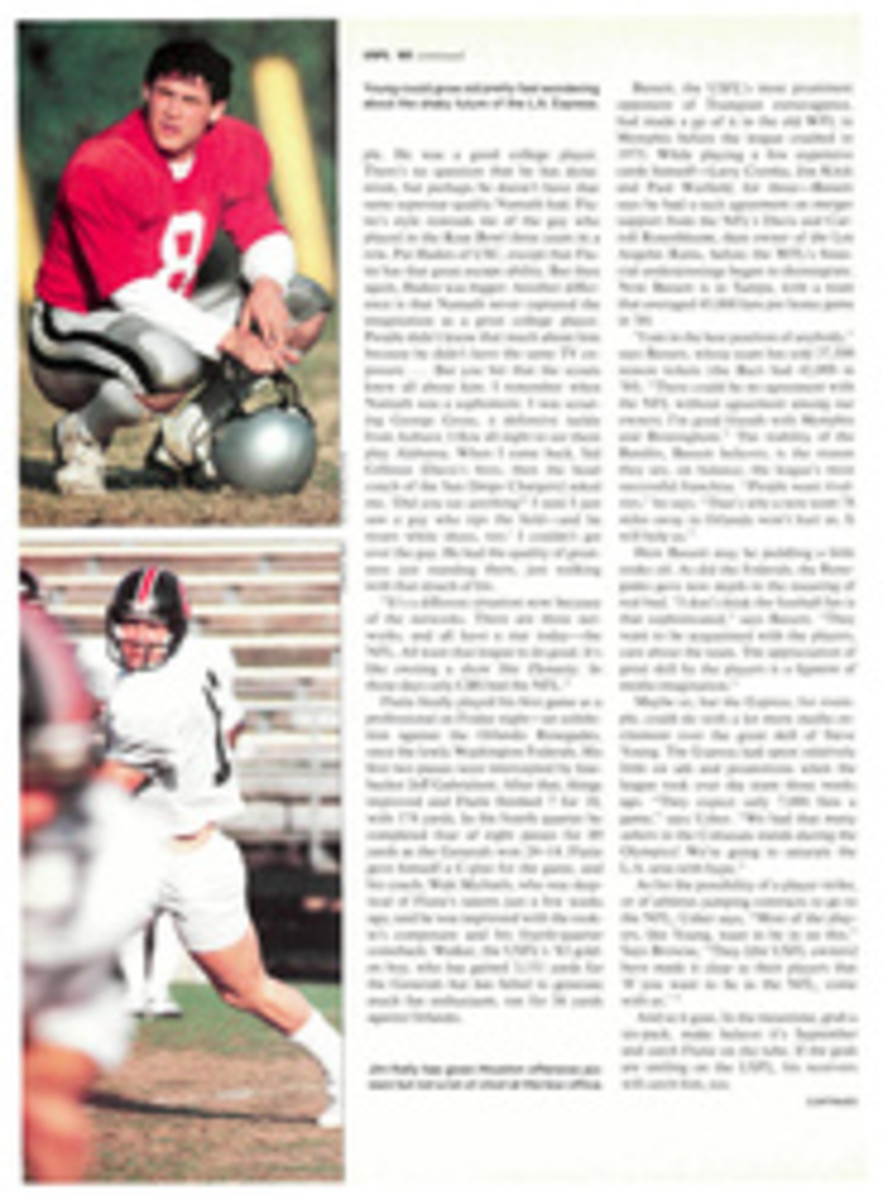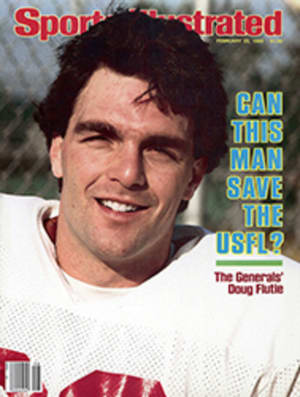
He Put A Feather In His Cap(s)
On Jan. 2, during a test for last Sunday's Daytona 500, Bill Elliott whipped his brand new Ford Thunder-bird around the 2.5-mile Daytona International Speedway at 202.2 mph, which was faster than Cale Yarborough's 1984 qualifying record there. Asked to describe that dazzling practice session Elliott said, "Well, we went down there and rode around and came home."
On Feb. 9, he was back at Daytona. This time he went 205.114 mph, to earn the pole for the 27th 500; it was the fastest lap in the history of stock-car racing. Five days later Elliott won his 125-mile qualifying race by two miles—a gap about as wide as the Atlantic in the fender-to-fender arena of NASCAR racing. "We tried to do all our homework, and I guess it showed," was all he said.
On Sunday, Elliott did what the other drivers had by now resigned themselves to as racing fate: He turned the Daytona 500 into his own Thunderbird cakewalk. And he did it ever so stylishly. Yarborough, also driving a T-Bird as he went for his third straight Daytona win, chased or paced Elliott for 62 laps, and Neil Bonnett, driving a Chevy, gave him a gutsy run until the final half-dozen laps. But there wasn't a car on the track that could match Elliott's 'Bird through the corners. Said Bonnett, "We could all run down the straightaways real fast, but the rest of us had to back off for the turns. Elliott just held his foot down and kept going."
"Here's like anyplace else," said the winner. "You got to have a car that can handle."
That bit of understatement may soon become classic. Elliott, a lanky, red-haired Georgia boy from near little ol' Dawsonville (pop. 342) who's known as Huckleberry around the NASCAR circuit for his Finn-like ways, hit the Big D in a way the place has rarely seen. Maybe never. Only Fireball Roberts (1962) and Yarborough (1984) have ever so completely ruled Speed Weeks by qualifying fastest and then winning both a 125-miler and the 500. Only Buddy Baker has ever won the 500 faster—a 177.602 average speed in 1980, while Elliott averaged 172.265. But it wasn't just the doing of one red-haired Elliott; three of them took on the combined might of NASCAR, and a silver-haired Elliott was on hand for good measure. Said Ricky Rudd, who finished fifth in another Thunderbird, "If those boys had a Rambler, they could probably make it run like that."
Those boys are George, 60, and his trio of redheaded sons—Ernie, 37; Dan, 34; and Bill, 29. Move over, Pettys, your days of familial dominance are over. Watch out, Wood Brothers, you may be done for, too. The Elliotts have moved in. What's more, they're a welcome addition to the community—Bill was voted NASCAR's most popular driver after winning three races and finishing 23 races in the top 10 last year. There has already been a Bill Elliott Day back in Dawsonville.
Sunday's win was a victory for every nose that has ever rubbed a grindstone. And for small towns, for backyards and close-knit families—not to mention Fords. The team began building its super 'Bird as soon as the '84 season ended back in November. They worked 16-hour days, seven days a week—including Christmas—in the off months. When they fired up their creation on Jan. 2, they had a head start that ultimately led to the checkered flag in NASCAR's richest race—a $185,500 first-place payoff out of a NASCAR-record $1.28 million total purse.
Bill began racing in 1974 at Dixie Speedway in Woodstock, Ga., and Ernie knew right away he wouldn't have to look any further than his kid brother for a driver, or for someone who would willingly work in the family speed shop—a converted schoolhouse—till midnight every night. Ernie now builds the engines, with brother Dan assisting him, while Bill describes himself as "general worker." But Bill sets up his own chassis. Those long legs seen sticking out from under car No. 9 in Daytona's garage area were Bill's. There's a moral to that part of the story: Drivers who do their own chassis have an edge on the ones with the clean fingernails.
"We think we have an advantage because we're not in the Charlotte huddle," says patriarch George, a Ford dealer, referring to the infestation of big-name stock car teams in the Charlotte, N.C. area. "That close to the others, you start worrying about what they're doing. I've been in this business since 1947, and the most trouble I've been in is when I've been worrying about what the other guys are doing."
Though the Elliotts have been racing Fords—and nothing but—for 11 years, they haven't been getting much technical and financial support from the factory. Most of that has gone to the Charlotte-based team of Yarborough and Waddell Wilson, crew chief and engine builder for five of the last six Daytona pole winners. So the Elliotts have had little choice but to go about their own business; Ernie develops the engines on the dyno and, with no wind tunnel, they guesstimate what the aerodynamics should be. Wouldn't you know, at Daytona the Wilson/Yarborough factory Ford had engine problems all through practice, and as Bill sailed around trouble-free, the Elliotts' lips were sealed. They had a better idea, and it will stay theirs alone for the time being.
The Wilson Thunderbird was hardly a slug, however. Yarborough qualified second-fastest, at 203.814 mph, and won the second of the two 125-milers on Thursday. As the 500 began, the front row brace of T-Birds pulled away from the second-row Chevy of David Pearson, while three other noted GM drivers began working up from 19th, 31st and 34th starting positions, respectively: Bonnett and the new Winston Cup champion, Terry Labonte, in their Chevys, and Bobby Allison in a Buick.
After 10 laps Elliott was setting a white-hot 199.557-mph pace. Elliott's first pit stop for gas was at 35 laps, 23 of which he had led. But after 50, Yarborough was in front, with Richard Petty third, 17 seconds behind Elliott. Then came Allison, Labonte, and Richard's son Kyle Petty in a Thunderbird.
An Ernie Elliott-built engine hasn't failed in a race since March 27, 1983, and he'd been wise enough to adjust the carburetor to a richer setting on race morning, because the gorgeous 70° day was hotter by 10° than any other during Speed Weeks. Swiftness was a given, reliability would be brother Bill's ultimate weapon. The Thunderbird began driving the other cars into the pavement one by one. First Kyle Petty pitted with an oil leak, and then Yarborough retired because of a burned piston. "I looked up and saw him dropping to the bottom of the ractrack," said Elliott, "but I really didn't have no feelin's about it one way or the other. Richard [Petty] was runnin' second then, and how many Daytonas has he won?" Seven, Bill.
Stars fell from the high banks left and right. Petty's Pontiac caught fire and jammed in fourth gear during a pit stop; Allison blew his engine; Dale Earnhardt blew his engine—"That smoking you saw was my elbows, from trying to hold the car on the track," he said; Benny Parsons burned a piston; A.J. Foyt's engine seized; Pearson burned a piston. The 195-mph pace of Elliott's 'Bird was getting to them.
When the smoke settled, Bonnett had bulled his way to second. He's a racer's racer, a tough, fair, no-excuses kind of guy. His qualifying speed had been third-fastest (202.584), but he'd started 19th after tire troubles in his 125-miler. "I just can't tell myself I'm racing for second," he said on the eve of the race. "We're going to come up with something. Nobody's unbeatable."
But Bonnett's Chevy was vibrating, and Elliott maintained a 37-second lead. Until he pitted on Lap 144, that is. Elliott was held in the pit by NASCAR officials as his crew was made to tape a loose headlight cover, and the stop took 41.2 seconds. It would not have been beyond NASCAR to detain the leader simply to make the race more exciting. However, neither would it have been beyond a crew to deliberately start the race with a loose headlight cover, which might conveniently fall aside during the proceedings—and let more cool air reach the engine on a warm day. Whatever, Elliott rejoined the race 20 seconds behind Bonnett.
Just before the 500, George Elliott had said, "You just work real hard and look for your day when everything goes your way." For him and his sons, this was going to be that day. Bill got a big break when a yellow light came out on Lap 162, enabling him to close to Bonnett's bumper. They both stopped for gas, and it was borderline whether they could go the remaining distance without stopping again—closer to the border for Elliott, because his richer fuel mixture meant poorer mileage. When the green came on, Elliott passed Bonnett—"The mother blew right by me!" Bonnett exclaimed over the radio to his crew chief—but Bonnett scooted back past Elliott, and stayed in the lead for eight laps as Elliott shrewdly stayed tight in Bonnett's draft to conserve fuel.
Another yellow came out on Lap 174, and Elliott could breathe easy after taking on gas. When the green came out on Lap 176, it was adios, Bonnett, as Elliott began cutting laps in the 198-mph range.
There was one more yellow. This one was for Bonnett, when the engine in his Monte Carlo went poof in Turn 4. "It dumped stuff onto the tires, and all I could do was hang on," he said. Which he did as the car slid all the way past the grandstands that held a goodly portion of the crowd of 140,000.
With one lap remaining, the green light came back on. Lake Speed, a former karting champion, had scrapped his way to second. "It came just in time," he said later, with moist eyes. There had been no sponsor—no money—on the evening before the race. But both had come along at the last minute and Speed, who won $85,705, can see a full-season campaign shaping up. Third, a lap down, was Darrell Waltrip in a Chevy.
This was Elliott's fifth Grand National victory, but it had taken him 116 races to get his first, at Riverside in 1983, and he isn't entirely used to the celebrity. With a sunburned face to match his hair and his 7-year-old daughter, Starr, hanging on him and hugging him, Elliott offered a final understatement for the day. Asked where the lipstick on his cheek had come from, he rubbed it and replied, "I think it might be growing on me."
PHOTO
GEORGE TIEDEMANN
Elliott's allegiances are many, which was only too evident in Victory Lane.
SEVEN PHOTOS
JOHN IACONO
[See caption above.]
PHOTO
JOHN IACONO
Elliott (9) couldn't shake Yarborough off his bumper until Cale's 'Bird burned a piston.
PHOTO
JOHN IACONO
Starr was awfully proud of her daddy's big win.
PHOTO
GEORGE TIEDEMANN
Bonnett (left) made a desperate dash for victory that grenaded his Chevy's engine.
PHOTO
JOHN IACONO
[See caption above.]

